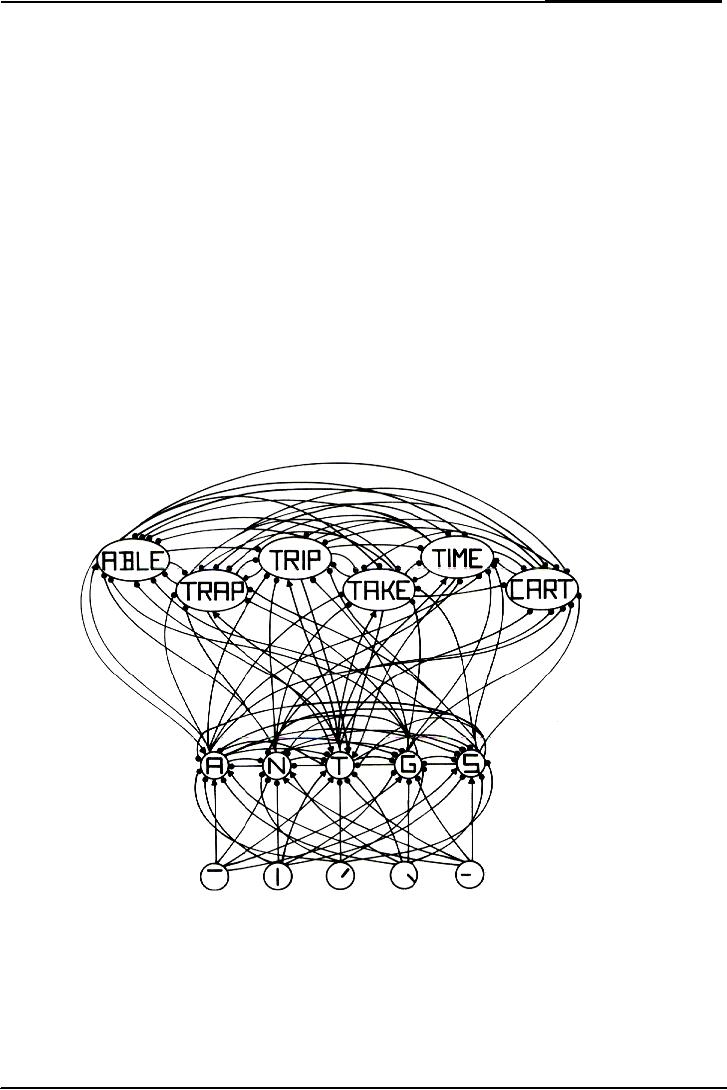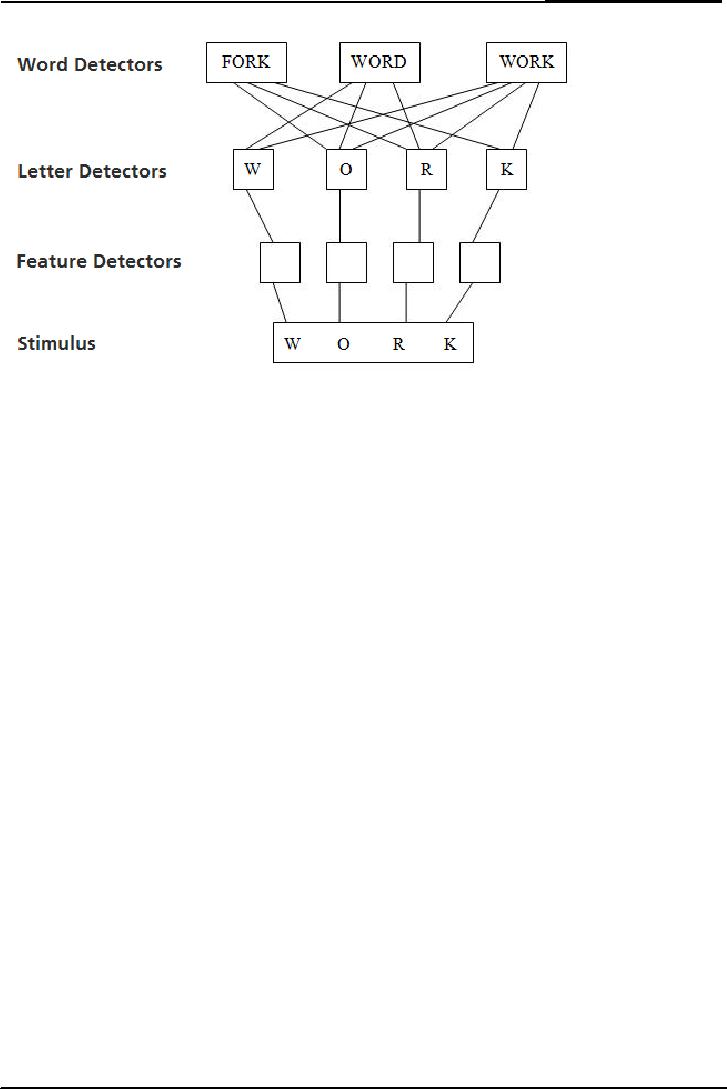 |
PATTERN RECOGNITION (CONTINUED):Neural Networks, Patterns of connections |
| << ATTENTION & PATTERN RECOGNITION:Word Superiority Effect |
| PATTERN RECOGNITION (CONTINUED):Effects of Sentence Context >> |

Cognitive
Psychology PSY 504
VU
Lesson
21
PATTERN
RECOGNITION (CONTINUED)
Neural
Networks
This
model is also called PDP's
or Parallel Distributed Processing.
McClelland and
Rumelhart
(1981)
made a pattern recognition
network. It solves the
paradox of bottom-up versus
top-down.
McClelland
and Rumelhart implemented
this network to model our
use of word structure
to
facilitate
recognition of individual letters. In
this model, individual
features are combined to
form
letters
and individual letters are
combined to form words. This
is connectionist model. It
depends
heavily
on excitatory and inhibitory
activation process. Activation
spreads from the features
to
excite
the letters and form
the letters to excite the
words. Alternative letters
and words inhibit
each
other. Activation can also
spread down from the
words to excite the
component letters. In
this
way a word can support
the activation of a letter
and hence promote its
recognition. In such a
system,
activation will tend to
accumulate at one word and
it will repress the
activations of other
words
through inhibition. The
dominant word will support
the activation of its
component letters,
and
these letters will repress
the activation of alternatives
letters. The word
superiority effect is
due
to the support a word gives
to its component letters.
The computation proposed
by
McClelland
and Rumelhart's interactive
activation model is extremely
complex, as is the
computation
of any model that stimulates
neural processing. This
process helps us in
understanding
how neural processing
underlies pattern recognition.
The figure of this model
is
given
below.
This
is the part of pattern-recognition
network proposed by McClelland
and Rumelhart to
perform
word
recognition by performing calculation on
neural activation values.
Connections with
arrowheads
indicate excitatory connections
from the source to the
head. Connections
with
rounded
heads indicate inhibitory
connections from the source
to the head. This net is
making
network.
65

Cognitive
Psychology PSY 504
VU
This
is simpler version of neural
network. This diagram is
showing a word WORK. At one
level
there
is feature detector. Feature
detectors are being not
showed. At another level
there are letter
detectors.
We recognize W because of features. O R
and K are recognized. All
words activate
because
of letters. Four words of
WORK are activated. These
three words are competitors
in
word
recognition. WORK is recognizing by
four letters. This is
parallel distributor
processing
model.
This is also called neural
network model of pattern
recognition model. This is
called neural
network
because there is an abstract
concept or quantity that
called nodes.
Neural
Networks
Neural
networks is consisted on
Nodes
Links
Excitatory
Inhibitory
Weights
Learning
consists of re-adjustment of
weights
Nodes
Nodes
are a set of processing
units. Nodes should not be
confused with neurons. Nodes
are hard
ware
level description. Nodes are
represented by features, letters
and words in the
interactive
activation
model. They can acquire
different levels of activation.
All boxes in above diagram
are
nodes.
Lines are links. Nodes
are connected through these
lines.
Patterns
of connections
Nodes
are connected to each other
by excitatory or inhibitory connections
that differ in
strength.
Another
important concept is activation
rules. These specify how a
node combines its
excitatory
and
inhibitory inputs with its
current state of
activation.
66

Cognitive
Psychology PSY 504
VU
Excitatory
connections
These
are those connections that
make other nodes active.
Those nodes are
connected
with
excitatory connections they
are active or
charged.
Inhibitory
connections
Those
connections that make other
nodes relax and switch
off.
Because
of these connections the
neural network
exists.
State
of Activation
Nodes
can be activated to various
degrees. We become conscious of
nodes that are
activated
above
a threshold level of conscious
awareness. We become aware of
letter K in the word
WORK
when it receives enough
excitatory influences from
feature and word
levels.
A
Learning Rule
Learning
generally occurs by changing
the weights of the
excitatory and inhibitory
connections
between
the nodes. The Learning
rule specifies how to make
these changes in the
weights.
Initial
weights
Re-adjustment
of weights
PDP
and learning
The
Learning component is the
most important feature of a
neural network model because
it
enables
the network to improve its
performance. In a lab in California a
computer learns how
to
speak
by reading and re-reading
simple English sentences
improving from its own
mistakes.
PDP
and its
significance
Parallel
processing models have
improved computer functioning.
That has made
super
computers.
Super computers are called
parallel computers. Multiple
processors that
communicate
with each other work
faster than serial
processing computers. The
paradoxes are
resolved.
Like forests are seen at
the same time as the
trees. Words are seen at
the same time
as
the letters. Context helps
in object perception; object
perception helps in perception of
context.
67
Table of Contents:
- INTRODUCTION:Historical Background
- THE INFORMATION PROCESSING APPROACH
- COGNITIVE NEUROPSYCHOLOGY:Brains of Dead People, The Neuron
- COGNITIVE NEUROPSYCHOLOGY (CONTINUED):The Eye, The visual pathway
- COGNITIVE PSYCHOLOGY (CONTINUED):Hubel & Wiesel, Sensory Memory
- VISUAL SENSORY MEMORY EXPERIMENTS (CONTINUED):Psychological Time
- ATTENTION:Single-mindedness, In Shadowing Paradigm, Attention and meaning
- ATTENTION (continued):Implications, Treisman’s Model, Norman’s Model
- ATTENTION (continued):Capacity Models, Arousal, Multimode Theory
- ATTENTION:Subsidiary Task, Capacity Theory, Reaction Time & Accuracy, Implications
- RECAP OF LAST LESSONS:AUTOMATICITY, Automatic Processing
- AUTOMATICITY (continued):Experiment, Implications, Task interference
- AUTOMATICITY (continued):Predicting flight performance, Thought suppression
- PATTERN RECOGNITION:Template Matching Models, Human flexibility
- PATTERN RECOGNITION:Implications, Phonemes, Voicing, Place of articulation
- PATTERN RECOGNITION (continued):Adaptation paradigm
- PATTERN RECOGNITION (continued):Gestalt Theory of Perception
- PATTERN RECOGNITION (continued):Queen Elizabeth’s vase, Palmer (1977)
- OBJECT PERCEPTION (continued):Segmentation, Recognition of object
- ATTENTION & PATTERN RECOGNITION:Word Superiority Effect
- PATTERN RECOGNITION (CONTINUED):Neural Networks, Patterns of connections
- PATTERN RECOGNITION (CONTINUED):Effects of Sentence Context
- MEMORY:Short Term Working Memory, Atkinson & Shiffrin Model
- MEMORY:Rate of forgetting, Size of memory set
- Memory:Activation in a network, Magic number 7, Chunking
- Memory:Chunking, Individual differences in chunking
- MEMORY:THE NATURE OF FORGETTING, Release from PI, Central Executive
- Memory:Atkinson & Shiffrin Model, Long Term Memory, Different kinds of LTM
- Memory:Spread of Activation, Associative Priming, Implications, More Priming
- Memory:Interference, The Critical Assumption, Limited capacity
- Memory:Interference, Historical Memories, Recall versus Recognition
- Memory:Are forgotten memories lost forever?
- Memory:Recognition of lost memories, Representation of knowledge
- Memory:Benefits of Categorization, Levels of Categories
- Memory:Prototype, Rosch and Colleagues, Experiments of Stephen Read
- Memory:Schema Theory, A European Solution, Generalization hierarchies
- Memory:Superset Schemas, Part hierarchy, Slots Have More Schemas
- MEMORY:Representation of knowledge (continued), Memory for stories
- Memory:Representation of knowledge, PQ4R Method, Elaboration
- Memory:Study Methods, Analyze Story Structure, Use Multiple Modalities
- Memory:Mental Imagery, More evidence, Kosslyn yet again, Image Comparison
- Mental Imagery:Eidetic Imagery, Eidetic Psychotherapy, Hot and cold imagery
- Language and thought:Productivity & Regularity, Linguistic Intuition
- Cognitive development:Assimilation, Accommodation, Stage Theory
- Cognitive Development:Gender Identity, Learning Mathematics, Sensory Memory